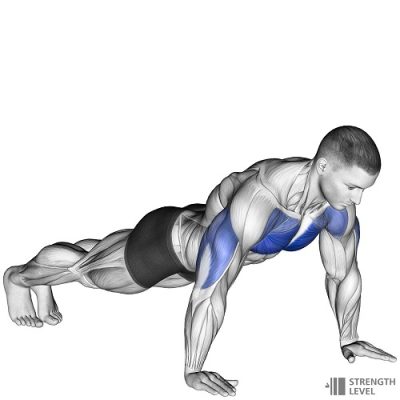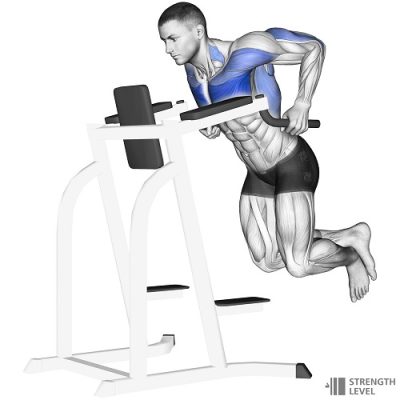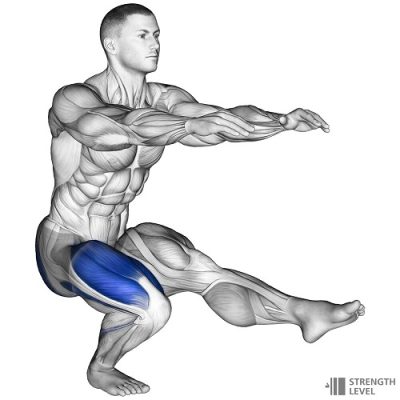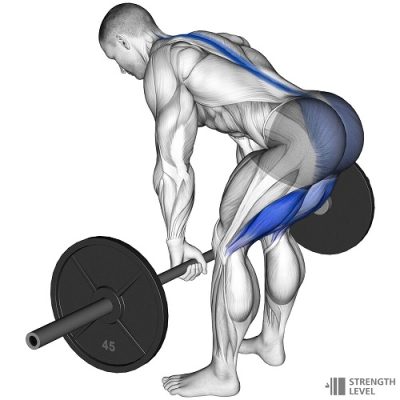Men’s health; exercise that can help boost libido and improve health
Exercise has been known to increase levels of testosterone in men. Studies have found that moderate-intensity aerobic exercise, such as jogging or cycling, can boost testosterone levels. Resistance training, such as weightlifting, has also been found to increase testosterone levels in men. Exercise has a wide range of other health benefits for men, including improved cardiovascular health, increased strength and muscle mass, reduced stress, and improved mental health.
Specific exercises that can help boost health and testosterone
Let’s talk about squats
Squats are a great exercise for men because they engage many large muscle groups, including the glutes, quads, and hamstrings. This can help to increase testosterone levels and improve overall strength. Squats are one of the best exercises for your lower body, as they work your quads, glutes, hamstrings, and calves. To perform a squat, start by standing with your feet shoulder-width apart and your toes pointing forward. Bend your knees and push your hips back to lower yourself down until your thighs are parallel to the floor, and then push back up to the starting position.
Another effective exercise is deadlifts:
Like squats, deadlifts engage large muscle groups, which can help boost testosterone. Deadlifts also have the added benefit of improving grip strength and core stability. To perform a deadlift, start by standing with your feet hip-width apart and your knees slightly bent. Hold the barbell with an overhand grip, with your hands just outside of your legs. Keeping your back straight, hinge at the hips and lower the bar to the floor, keeping it close to your legs. Then, drive through your heels to stand up, and bring the barbell back to the starting position.
There are a few things to keep in mind when performing a deadlift. First, make sure to keep your core engaged and your back straight throughout the movement. Second, don’t round your shoulders or your back as you lower the bar. Third, don’t allow your knees to cave inwards during the movement. And finally, keep your head and neck in line with your spine.
Another great option is bench presses:
Bench presses are an effective way to build strength in the chest, shoulders, and triceps. They also engage the core and can help to increase testosterone levels. In addition to these exercises, high-intensity interval training (HIIT) has been shown to increase testosterone levels. HIIT involves short bursts of high-intensity exercise followed by periods of rest. It can be a highly effective way to get a workout in a short amount of time.
One popular HIIT workout is called the Tabata method. Tabata involves 20 seconds of high-intensity exercise followed by 10 seconds of rest, repeated for 4 minutes. This can be done with any exercise, such as jumping jacks, burpees, or sprinting. Another popular HIIT workout is the AMRAP (as many reps as possible) method. With AMRAP, you choose one exercise and perform as many reps as possible in a given amount of time.
It’s also important to note that rest and recovery are just as important as exercise when it comes to boosting testosterone. Getting enough sleep is crucial for recovery and optimal hormone production. Studies have shown that men who get less than 5 hours of sleep per night have lower testosterone levels than those who get 7-8 hours of sleep. Additionally, reducing stress levels can also help to increase testosterone. This can be done through activities like meditation, yoga, and deep breathing.
Let’s move on to another effective exercise for men: pull-ups
Pull-ups are a great way to build strength and muscle mass in the upper body. They’re also a compound exercise, meaning they engage multiple muscle groups, including the biceps, back, and core. To perform a pull-up, start by gripping the bar with an overhand grip, with your hands shoulder-width apart. From there, pull yourself up until your chin is above the bar, and then lower yourself back down to the starting position.
If pull-ups are too challenging, there are easier variations you can try. For example, you can start with negative pull-ups, where you jump up to the bar and then lower yourself slowly down. Another option is band-assisted pull-ups, where you attach a resistance band to the bar and place your knee or foot in the band to assist you. These are great ways to build up to a full pull-up.
Let’s talk about push ups
Push-ups are a classic upper-body exercise that work your chest, shoulders, and triceps. To do a push-up, start in a plank position with your hands directly underneath your shoulders. Keep your core tight and lower yourself down until your chest is close to the floor. Push back up to the starting position and repeat.

To make push-ups more challenging, you can try doing them on an incline or decline, which increases the range of motion and recruits different muscle groups. You can also try doing them with your hands in a staggered position, which adds an element of instability and makes the exercise more difficult. If you’re looking for even more of a challenge, you can try doing clap push-ups, where you push yourself up explosively and clap your hands before lowering yourself back down. Does all of that sound doable?
Now, let’s move on to another great exercise: chin-ups:
Chin-ups are similar to pull-ups, but they use an underhand grip instead of an overhand grip. They’re also sometimes called “pull-ups” by mistake, so just be aware of the difference. To do a chin-up, start by hanging from a bar with an underhand grip and your arms fully extended. Engage your core and pull yourself up until your chin is above the bar, and then lower yourself back down to the starting position.
You can make chin-ups more difficult by adding weight. This can be done with a weight belt or a weighted vest. You can also add difficulty by doing them with one arm. Another variation is the L-sit chin-up, where you hold your legs straight out in front of you while doing the chin-up. This adds extra challenge to your core and abs.
Next up is dips
Dips are a bodyweight exercise that uses your own bodyweight to work the triceps and chest. To perform a dip, start by gripping the bars of a dip station or parallel bars. Lower yourself down until your elbows are at a 90-degree angle, and then push yourself back up to the starting position. Dips can be challenging, but they’re a great way to build upper-body strength. Have you ever tried dips before?

It’s not a problem if you haven’t. Dips can be modified to make them easier to start with. You can do this by using a bench or chair to support yourself and take some of the weight off your arms. As you get stronger, you can gradually increase the difficulty by lowering the bench or chair until you’re able to do full dips. Another option is to do wall-supported dips, where you lean against a wall to support some of your weight.
Now that we’ve covered some basic exercises, let’s talk about a more advanced one:
The pistol squat.
A pistol squat is a one-legged squat that really challenges your balance and stability. Start by standing on one leg, with the other leg held straight out in front of you. Bend your knee and lower yourself down until your hips are parallel to the ground, and then push yourself back up to the starting position. Pistol squats are quite difficult, but they’re a great way to build strength and stability. Have you ever tried a pistol squat before?

That’s okay, they’re definitely not for beginners! If you’re interested in working up to a pistol squat, you can start with a supported pistol squat. To do this, hold onto a pole or chair to help support yourself while you lower down and come back up. You can also try using a band to assist you. Over time, you can gradually reduce the support you’re using until you’re able to do a full pistol squat. Does that sound like something you’d like to try?
The Romanian deadlift:
A Romanian deadlift is similar to a traditional deadlift, but the focus is more on your hamstrings and glutes. To perform a Romanian deadlift, start by standing with your feet shoulder-width apart, holding a barbell or a pair of dumbbells. Bend your knees slightly and hinge at the hips, lowering the barbell toward the floor while keeping your back flat and your core tight.

Certainly! Once you’ve lowered the weight as far as you can without rounding your back, drive through your heels to come back up to the starting position. Make sure to keep your core tight and your back flat throughout the entire movement. Romanian deadlifts are an excellent way to strengthen your hamstrings and glutes, and they can also help improve your posture and mobility.
Note that deadlift and Romanian deadlifts are not the same.
Now, let’s move on to the next exercise: the kettlebell swing:
Kettlebell swings are a full-body exercise that work your glutes, hamstrings, back, and core. To do a kettlebell swing, start by standing with your feet shoulder-width apart and holding a kettlebell in both hands. Hinge at the hips and swing the kettlebell between your legs. Then, drive through your hips and swing the kettlebell up to chest height. Keep your core engaged throughout the movement.
Now, let’s move on to another one: the Turkish get-up:
The Turkish get-up is a full-body exercise that requires a kettlebell. Start by lying on your back with the kettlebell in your right hand, your arm straight up over your chest. Push yourself up to a seated position, then get onto your left knee. From there, stand up, keeping the kettlebell over your head. Reverse the movement to return to the starting position.
One thing to keep in mind with the Turkish get-up is to take it slow and focus on proper form. Once you’ve mastered the basic version, you can try variations such as doing it on one leg or adding a press at the top.
Another one is called the burpee
Burpees are a high-intensity exercise that combines squats, jumps, and push-ups. Start by standing with your feet shoulder-width apart. Squat down, then place your hands on the floor and jump your feet back into a plank position. Do a push-up, then jump your feet back in toward your hands. Finally, jump up into the air with your arms overhead. Sounds challenging? It’s definitely not easy! But the burpee is a great exercise for burning calories and building strength and endurance. And you can modify it to make it easier or harder. For example, you can do a “squat thrust” by skipping the jump and stepping your feet back instead of jumping. Or you can make it harder by adding a tuck jump at the top. Do you think you can give it a try?
Rest days
Now that we’ve covered a few exercises, let’s talk about the importance of rest days. It’s important to give your body time to recover between workouts. When you work out, you create tiny tears in your muscle fibers. Your body needs time to repair these tears so your muscles can grow and get stronger. Taking a day or two off from exercise each week will help you avoid injury and make your workouts more effective. Do you currently schedule rest days?
Well, it’s definitely something to consider! A common recommendation is to take at least one or two days off from intense exercise each week. But it’s also important to make sure you get plenty of restful sleep every night. When you sleep, your body produces growth hormone, which helps repair and rebuild muscles. So, make sure you’re getting at least 7-8 hours of sleep each night. Does that sound reasonable?
Rest days and sleep are both important, but so is nutrition. Eating a balanced diet that includes protein, carbohydrates, and healthy fats will help your body recover from exercise and build muscle. Make sure to eat plenty of fruits, vegetables, and whole grains. And don’t forget to stay hydrated!
One last thing! Stretching is often overlooked, but it’s an important part of any fitness routine. Stretching helps increase your range of motion, improves flexibility, and may even reduce soreness after exercise. It’s especially important to stretch after a workout. Do you currently stretch?
I would definitely recommend adding stretching exercises to your routine! There are lots of different ways to stretch, so you can find something that works for you. Some popular methods include static stretching, dynamic stretching, and foam rolling. Static stretching involves holding a stretch for a certain amount of time. Dynamic stretching involves moving through a range of motion. And foam rolling is a technique that uses a foam roller to massage and stretch muscles. Would you like to hear more about these methods?
Let’s start with static stretching:
This is the most common type of stretching, and it’s easy to do. To do a static stretch, hold a stretch for 10-30 seconds. For example, to stretch your hamstrings, sit on the floor with your legs out in front of you. Then, reach forward and try to touch your toes. Hold the stretch for 10-30 seconds, then release. Repeat on the other side. It’s important to avoid bouncing while doing static stretches.
Now, let’s move on to dynamic stretching:
This type of stretching is done by moving through a range of motion, rather than holding a static stretch. For example, you could do arm circles, leg swings, or trunk twists. Dynamic stretching helps to warm up your muscles and prepare them for exercise. It’s a great way to start your workout. Do you think you could add some dynamic stretches to your routine?
I’d recommend starting with some dynamic stretches before every workout. Now, let’s talk about foam rolling. This is a technique that uses a foam roller to massage your muscles. The roller helps to release tension and knots in the muscles. You can use a foam roller on any part of your body, but it’s especially useful for your back, legs, and glutes.
If you do not have access to a foam roller, there are other ways to get the same benefits. You can use a tennis ball or a massage stick to massage your muscles. You can also try doing some self-massage techniques with your hands. Just use your fingers to apply pressure to the areas that are tight or sore. Does that sound like something you could try?
One more thing to keep in mind is the importance of breathing during stretching. When you’re stretching, it’s important to breathe deeply and slowly. This will help to relax your muscles and increase the benefits of the stretch. Breathing correctly can really make a big difference in how effective your stretching is. Now, let’s talk about how often you should stretch. For most people, it’s best to stretch at least 3-4 times per week. You can do it on the days you exercise, or on your rest days. The most important thing is to make stretching a regular part of your routine. Do you think you can do that?
Stretching can be a bit of a chore, but it’s definitely worth it. Remember, consistency is key when it comes to stretching. The more often you stretch, the more benefits you’ll see. Are you motivated to make stretching a regular part of your routine?
Let’s talk about the best time to stretch:
Generally, it’s best to do your stretching after your workout. This is when your muscles are warm and most receptive to stretching. But, if you have a busy schedule, it’s also okay to do your stretching at another time of day. Just be sure to warm up your muscles with some light activity first. Have you been stretching at the right time?
As mentioned before, it’s best to stretch after your workout when your muscles are warm. However, if you’re short on time, you can also do your stretching first thing in the morning, before you start your day. Or, you can do it in the evening, before bed. If you’re stretching at a different time than right after your workout, make sure to do a warm-up first, like a few minutes of light walking or jogging.
Pay attention to your body and listen to how it feels when you stretch. Don’t push yourself too hard, and stop if you feel any pain. You should feel a gentle stretch, but not pain. How does that sound?
I’m so glad you’re on board! Remember, stretching is not only beneficial for your flexibility, but also for your overall health. It can help to improve your posture, circulation, and joint health. Plus, it can help to reduce stress and anxiety. Do you feel less stressed after stretching?
The stress-reducing benefits of stretching are due to the release of endorphins. Endorphins are hormones that are released in response to physical activity, and they can help to boost your mood and reduce stress. They’re also known as the “feel-good” hormones. Do you feel like stretching gives you a mood boost?
A few words of encouragement?
Remember, it’s important to be patient and consistent with your stretching routine. Don’t expect to see results overnight. But, if you stick with it, you’ll start to see the benefits over time. So, keep stretching, and keep feeling good!
Your Wellness Is Our Ultimate Priority At Fekomi Wellness
Our team of highly qualified and certified healthcare consultants at Fekomi wellness are always ready and happy to help you with your health concerns. Visit Fekomiwellness today to book an appointment and get started on your health journey. Kindly call our desk line on +2349074197154 for more enquiries.

